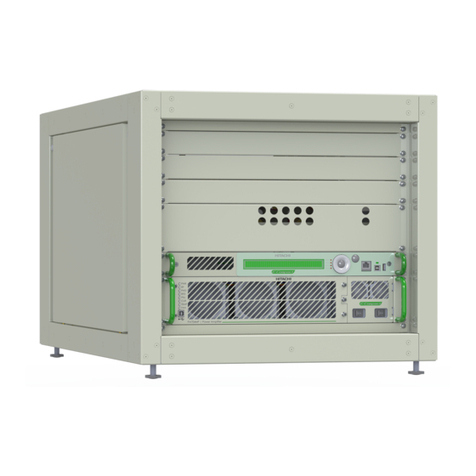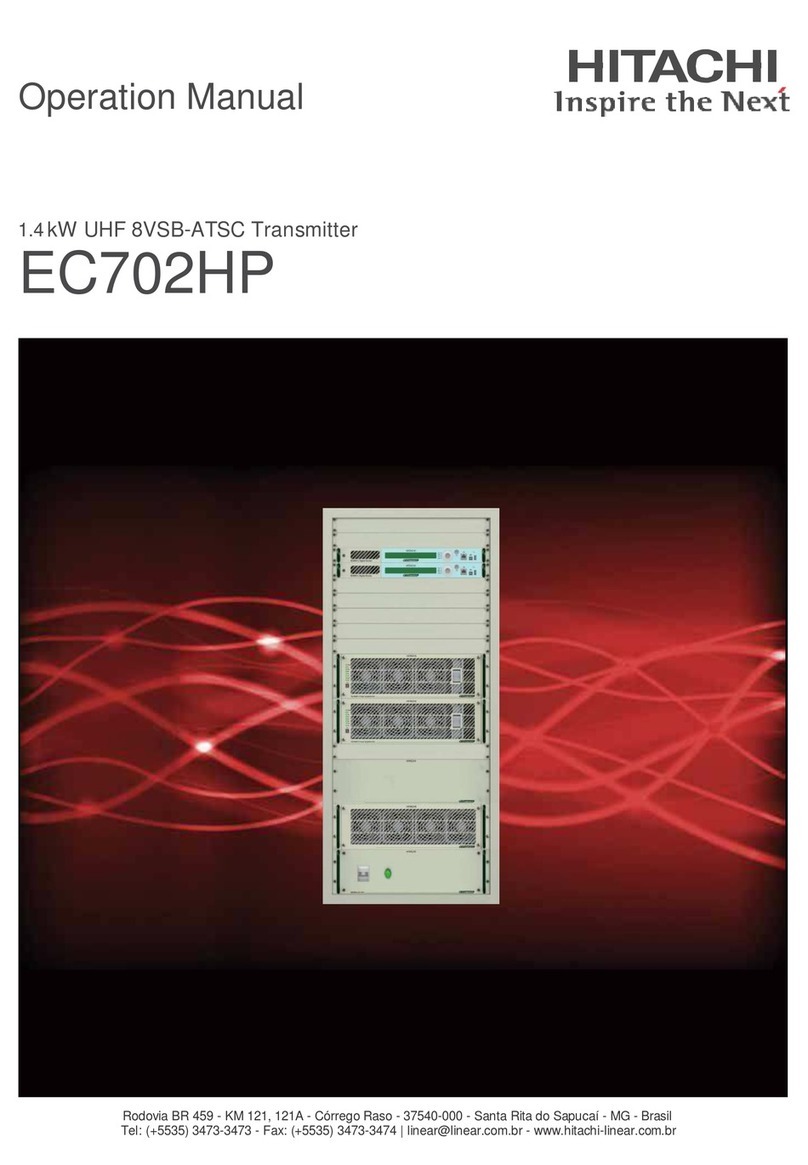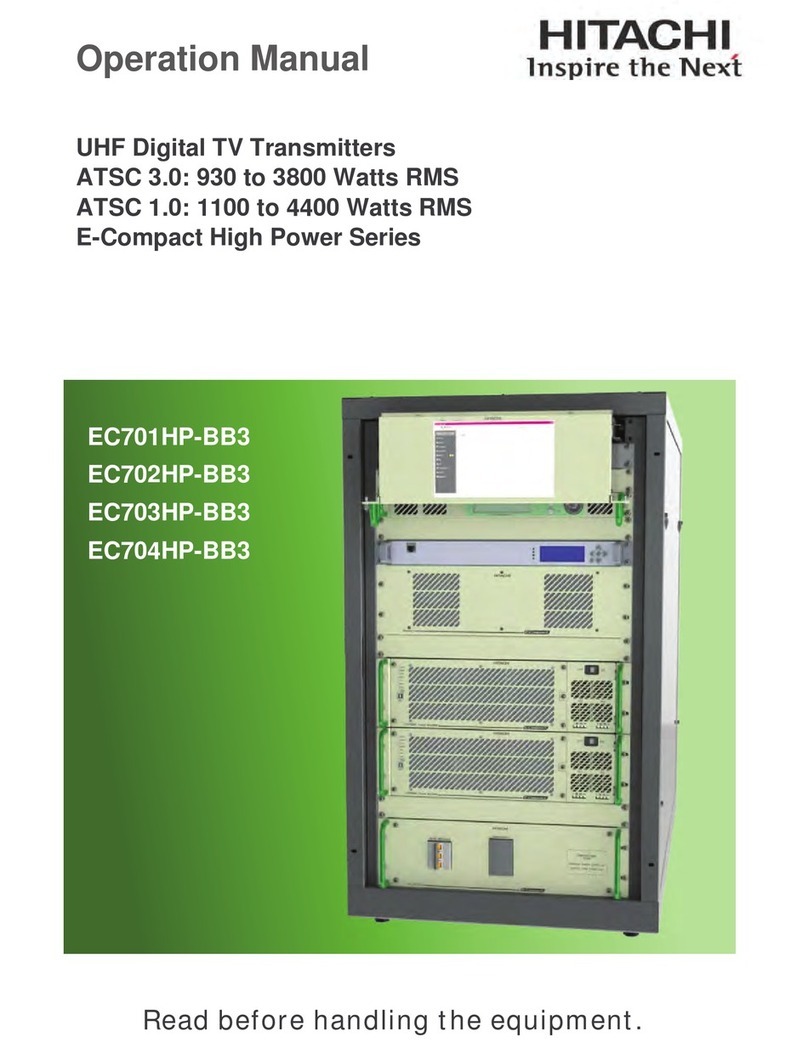
Top view ............................................... 3-10
External Connections ............................ 3-26
Photo - EC701HP Tansmitter ......................... 1-21
1
Indice
Section 1 - Introduction
1.1 Purposeof thisManual................................................ 1-1
1.2 Basic Knowledge Required ........................................ 1-1
1.3 Structure.......................................................................... 1-1
1.4 GeneralDescription .................................................... 1-2
1.4.1 Transmitter’s Control System ........................ 1-3
1.4.2 E-Compact ATSC Transmitters Models ....... 1-6
1.4.3 Composition...................................................... 1-6
1.4.4 Block Diagram of the System ......................... 1-7
1.4.5 Functional Description of the System ........... 1-8
1.4.5.1 ATSC Digital Exciter ............................. 1-8
1.4.5.2 Coaxial Relay (Optional Dual Excitation)
............................................................................... 1-14
1.4.5.3 Power Splitter....................................... 1-14
1.4.5.4 UHF Power Amplification System .... 1-14
1.4.5.5 Power Combiner................................. 1-17
1.4.5.6 LoadsBank .......................................... 1-17
1.4.5.7 Filtering System ................................... 1-18
1.4.5.8 RF Sampling Probe ............................ 1-18
1.4.5.9 Power Supplies................................... 1-18
1.4.5.10 Electrical Distribution Drawer (MCCB)
.............................................................................. 1-19
1.4.5.11 Cooling System ................................. 1-19
1.5 Technical Specification - E-Compact TV ATSC
Transmitters...................................................... 1-20
1.6
Section 4 - Initial Activation
4.1 Introduction.......................................................... 4-1
4.2 Connections and Final Checks ....................... 4-9
4.3 Possible operations with the Transmitter in
Operation............................................................. 4-9
4.3.1 Communication....................................... 4-9
4.3.2 Serial terminal Emulators ..................... 4-10
4.3.3 Forbidden operations ............................ 4-10
4.3.4 Safeguards.............................................. 4-10
4.4 Automatic Power reduction Table .................... 4-11
Section 2 - Minimum Installation
Requirements
2.1 Introduction..................................................................... 2-1
2.2 Minimum Requirements .............................................. 2-1
2.2.1 Electric Power.................................................... 2-1
2.2.1.1 Grounding ........................................................ 2-1
2.2.1.2 Stability.............................................................. 2-1
2.2.1.3 Insulation ......................................................... 2-2
2.2.1.4 WireGage........................................................ 2-4
2.3 Atmospheric Discharge Protection System ............. 2-4
2.3.1 LightningArresters............................................. 2-4
2.3.2 CableProtectors ................................................ 2-4
2.4 AirConditioning .............................................................. 2-5
2.4.1 Temperature....................................................... 2-5
2.4.2 Humidity.............................................................. 2-5
2.4.3 Cooling............................................................... 2-5
3.7.2.2Internal Connections ............................. 3-21
Connections............................................3-21
Assembly Instructions ........................... 3-19
On Site Physical Assembly ............................... 3-19
AC Power Cable Connections .......... 3-18
Power Feeding Options ........................ 3-18
Power Network Connections ........................... 3-18
TopPanel................................................ 3-173.5.3
Section 3 - Installation
3.1 Introduction...........................................................3-1
3.2 Inspection .............................................................3-1
3.3 Installation Recommendations ....................... 3-1
3.3.1 Preventive Protection ............................ 3-1
3.3.2 Tower....................................................... 3-2
3.3.3 Fastening of cables, antennas and
connectors.............................................. 3-2
3.3.4 Equipment Installation Indoors ........... 3-4
3.3.5 Equipment Grounding .......................... 3-4
3.3.6 Electric Installation Grounding ............ 3-5
3.3.7 PowerSupply.......................................... 3-5
3.4 MechanicalDrawings.......................................... 3-6
3.4.1 FrontView................................................ 3-6
3.4.2 Rear View................................................. 3-7
3.4.3 Isometric view ......................................... 3-8
3.4.4 Dimensions (mm) .................................. 3-9
3.4.5
3.5 FrontPanel.......................................................... 3-11
3.5.1 DigitalExciter.......................................... 3-11
3.5.2 PowerDrawer ........................................ 3-14
3.6
3.6.1
3.6.2
3.7
3.7.1
3.7.2
3.7.2.1































